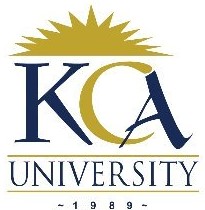
UNIVERSITY EXAMINATIONS: 2017/2018
EXAMINATION FOR THE DIPLOMA IN INFORMATION TECHNOLOGY
DIT406 HUMAN COMPUTER INTERACTION
FULLTIME/PARTTIME
DATE: APRIL 2018 TIME: 1
1
/2 HOURS
INSTRUCTIONS: ATTEMPT ANY THREE QUESTIONS.
QUESTION ONE
a) Explain how the following disciplines contribute to HCI: [5 Marks]
i. Computer science.
ii. Cognitive psychology.
iii. Social and organization psychology.
iv. Ergonomics or human factors.
v. Linguistics.
b) Briefly discuss the following types of memory: [6 Marks]
i. Sensory memory
ii. Short term memory
iii. Long term memory
c) The focal point of Gestalt theory is the idea of “grouping,” or how we tend to interpret a visual
field or problem in a certain way. Explain briefly the four main factors that determine grouping.
[4 Marks]
d) When designing user interfaces there are important factors that a designer should consider.
List down FIVE considerations for commands. [5 Marks]
QUESTION TWO
a) Discuss THREE major principles of direct manipulation. [6 Marks]
b) Differentiate between “affordance” and “visibility” as used in usability principle.
[4 Marks]
c) False affordance is an apparent affordance that has no real function. False affordance is a major
contributor to lower web site conversion and lost online sales. This is because a false affordance
breaks the faith a web site visitor has in the web site functional abilities, and causes doubt and
confusion. Explain FOUR damages that false affordance can cause. [4 Marks]
d) Explain THREE primary types of testing that can be used to analyze and optimize perceived
affordance. [6 Marks]
QUESTION THREE
a) Touch displays allow the user to input information into the computer simply by touching an
appropriate part of the screen. This kind of screen is bi-directional – it both receives input and it
outputs information. Outline FOUR disadvantages of Touch screens. [4 Marks]
b) Fitts’ Law states that big targets at close distance are reached faster than small targets at long
range. Outline the principles used when applying Fitts’ Law to interface designs.
[3 Marks]
c) FORM- FILL enable a user to type data in specific fields, similar to the fields on a paper fill-in
form. Many office and database applications use this style. Form-fill is also widely used in web
pages, to obtain feedback or to elicit customer details in transactions. Discuss issues that should
be considered when designing FORMS. [7 Marks]
d) Well-designed direct manipulation systems tend to make the interaction enjoyable for the users.
Explain why basing your answer to Shneiderman. [4 Marks]
e) Using examples give TWO common methods of direct manipulation [2 Marks]
QUESTION FOUR
a) Describe verbal metaphors using the typewriter and computer as examples [4 Marks]
b) Define the interface metaphor [2 Marks]
c) Explain how FOUR Gestalt laws of grouping can be used in interface design [8 Marks]
d) Describe distributed cognition. Give an example [4 Marks]
e) Give the goals of HCI [2 Marks]
QUESTION FIVE
a) Define usability [2 Marks]
b) Describe FIVE Nielsen Usability Heurestics [10 Marks]
c) Give meaning to CSCW [2 Marks]
d) Give TWO examples of collaborative software [2 Marks]
e) Discuss privacy and floor control design issues associated with CSCW [4 Marks]
